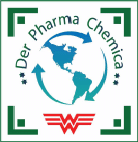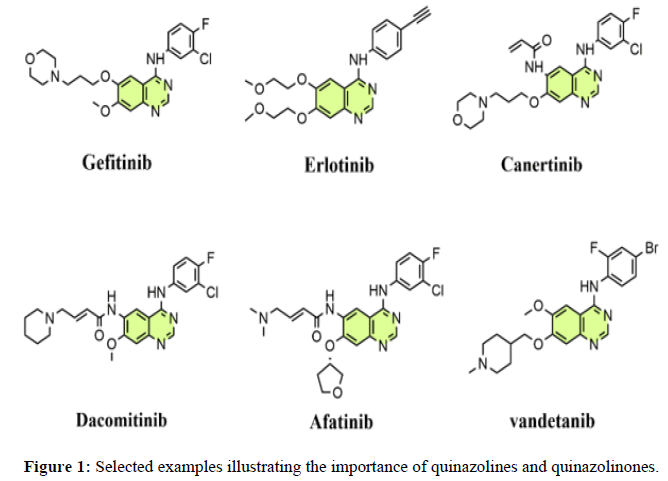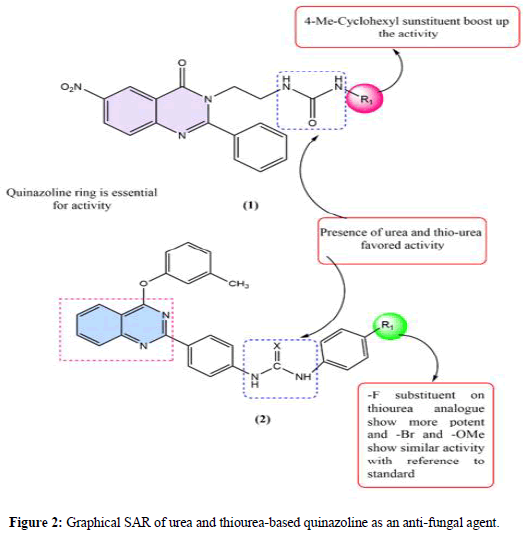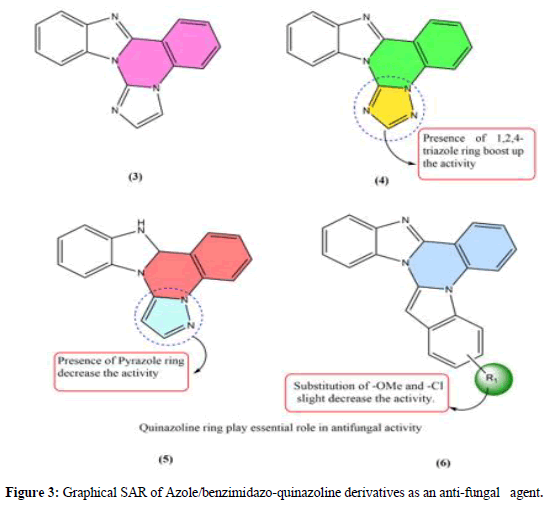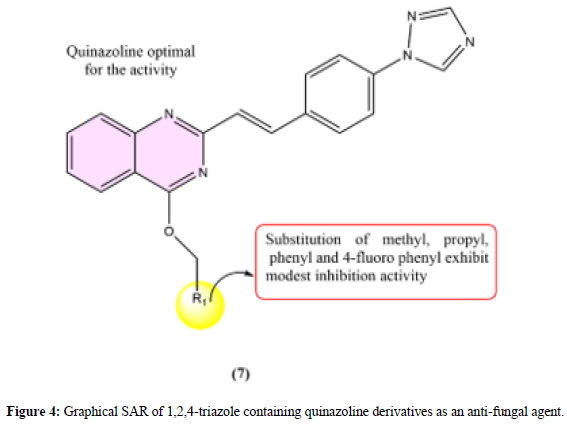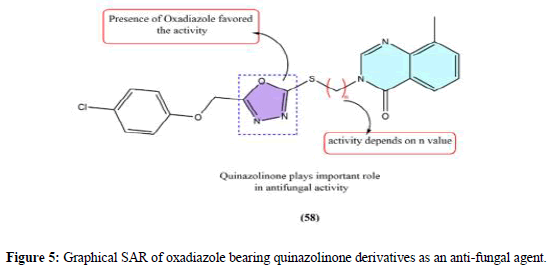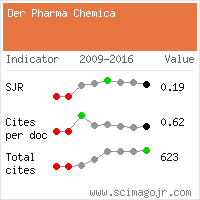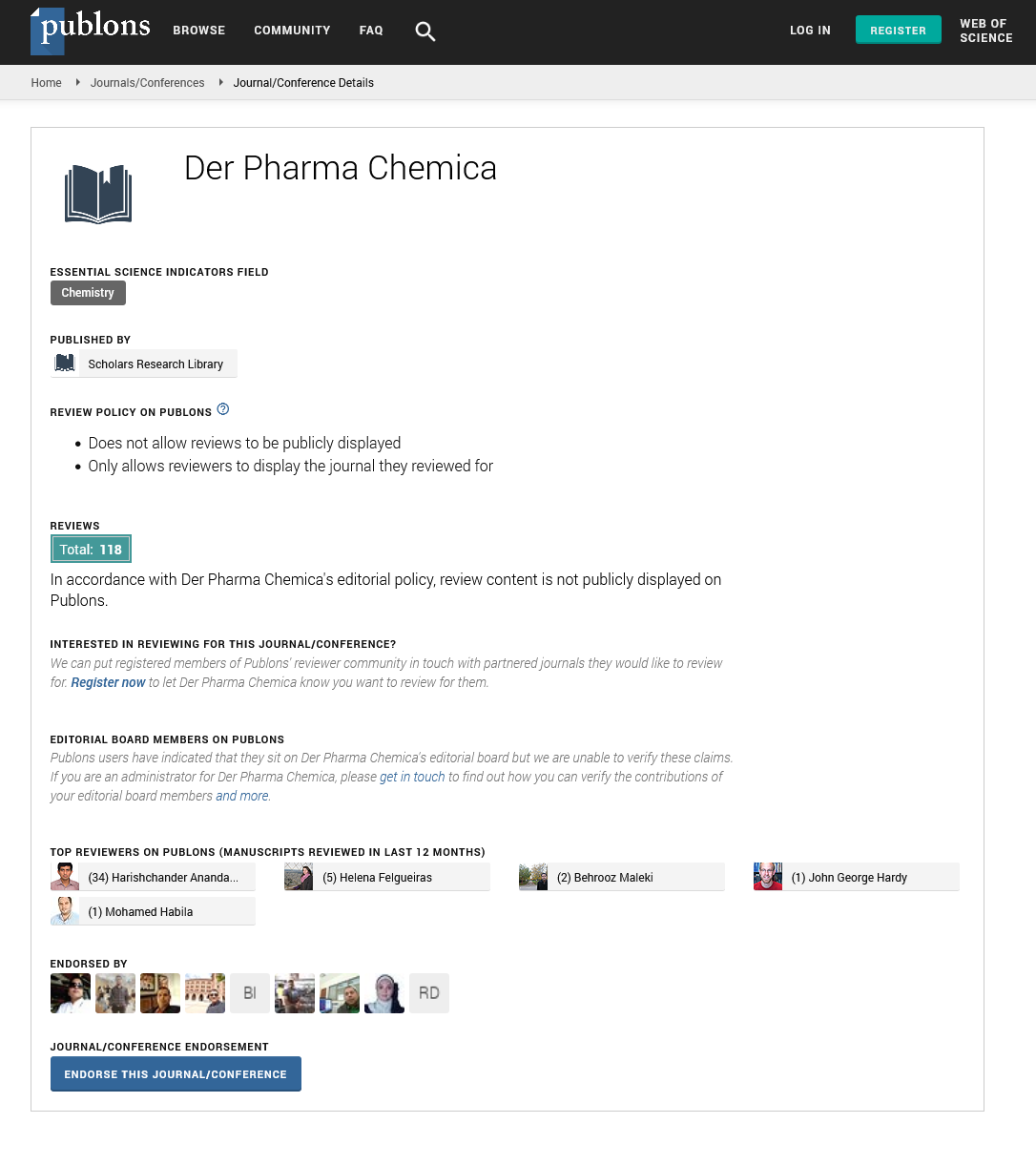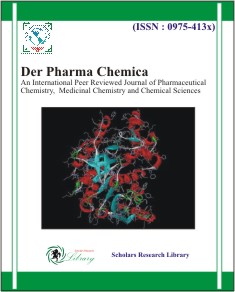Research Article - Der Pharma Chemica ( 2025) Volume 17, Issue 1
Review on Quinazoline Based Analogues, their Binding Sites with Various Fungal Strains and their Structure Activity Relationship Studies
Aniruddhasinh M. Rana* and Kirtika PatelAniruddhasinh M. Rana, Department of Pharmaceutical Sciences, Sajjan Institute of Sciences, Gujarat, India, Email: aniruddha.m.rana@gmail.com
Received: 26-Mar-2024, Manuscript No. DPC-24-130768; Editor assigned: 29-Mar-2024, Pre QC No. DPC-24-130768 (PQ); Reviewed: 12-Apr-2024, QC No. DPC-24-130768; Revised: 01-Feb-2025, Manuscript No. DPC-24-130768 (R); Published: 28-Feb-2025, DOI: 10.4172/0975-413X.17.1.592-597
Abstract
The drug resistance problem is most acute in the case of fungal. There is always a need to develop novel antifungal drugs with better mechanisms of action. Most of the quinazoline-based antibiotics developed are potential antibacterial drug candidates. This review represents quinazoline/quinazolinone-based hybrids with antifungal activity and their Structure Activity Relationship (SAR). An attempt has been made to explore various binding sites of quinazoline based heterocyclic analogues with various fungal strains. Structure activity relationship studies of the same analogues have been carried out, that provides better insight into the improvement of quinazoline/quinazolinone based antibiotics especially against multidrug-resistant fungal strains.
Keywords
Quinazoline; Antifungal; SAR; Docking
Introduction
The number of life-threatening infectious diseases caused by multidrug-resistant fungal has reached an alarming level in many countries around the world. The ever-growing demand for material protection from microbial contamination is a serious challenge. Despite great effort from the pharmaceutical industry to manage the resistance problem, the discovery and development of new mechanistic classes of antimicrobial has found very little success. Currently, term “black fungus” has been widely applied to human pathogenic Mucorales in India. subsequent contagion caused by black fungal infection, has threatened the whole of India and affected patients who are still recovering from COVID-19. black fungus infection caused by fungi Mucorales genera commonly found in our surrounding environments (for instance, soils, plants, manure and rotting fruits and so on), has recently grown a buzzword globally, mainly in South Asian countries. Though the exact epidemiological data of this infection is unknown, the prevalence of this black fungus infection in India is eighty (80) times higher than in developed countries. Due to this fungal infection, the mortality rate might be up to 96% depending on the severity of the invasion and underlying patients’ health situations. Black fungus (Auricularia auricula) is one of the four most important cultivated edible fungi in the world. Nitrogen-containing heterocycles are ubiquitous scaffolds of many natural products and are being widely used in the field of pharmaceuticals.
Among them, quinazoline derivatives are of utmost interest for a wide cross-section of chemists due to their remarkable bioactivities. Quinazoline and quinazolinone derivatives represent one of the most active classes of compounds possessing a wide spread and diverse pharmacological activities. Quinazoline and quinazolinone derivatives are reported to possess antibacterial, antifungal, antitumor, anti-inflammatory, anti-tubercular, antimalarials, anticancer, antiproliferative, hepatitis B virus, antileishmanial, urease inhibitors, pancreatic lipase inhibitors, oxidase-A inhibitors, α-glucosidase inhibitors, α-amylase inhibition, PARP-1 inhibitors, tyrosinase inhibitors. Some quinazoline and quinazolinone derivatives are already available in the medicinal world as an antimicrobial agent such as gefitinib, canertinib, afatinib, asperlicin C, doxazosin, etc. This review represents the detailed SAR of potential antifungal activity counter to pathogens of quinazoline based analogoues to get insight into the development of potent antifungal agent (Figure 1) [1-3].
Materials and Methods
Quinazoline and quinazolinone based derivatives showed potential antifungal activities
There is always a need for novel antifungal since many fungal strains have already generated resistance against antibiotics.
Urea and thiourea-based quinazoline derivatives: Urea based series of quinazoline derivatives were synthesized by Aniruddhasinh M. Rana and co-workers and screened for their antifungal activity against C. albicans fungal strain using fluconazole as a standard. As mentioned in Table 1, Figure 2 all tested compound showed moderate to good antifungal activity as compared to fluconazole with 10 μg/ml-40 μg/ml MIC value. SAR study revealed that compound with 4-Me-Cyclohexyl substituent 1c in the place of R1 was found to be the most active as shown in Table 1, Figure 2 [4,5].
| Compound | R1 | Antifungal activity (MIC: µg/ml) |
|---|---|---|
| C. albicans | ||
| 1a | Ph | 20 |
| 1b | Cyclohexyl | 20 |
| 1c | 4-Me-Cyclohexyl | 10 |
| 1d | 2-Cl-Ph | 20 |
| 1e | 2-Me-Ph | 20 |
| 1f | 4-Me-Ph | 20 |
| 1g | 3,5-bis (CF3)-Ph | 20 |
| 1h | 4-SCH3-Ph | 20 |
| 1i | 2-Cl-5-CF3-Ph | 20 |
| Flucanazole | - | 5 |
Table 1: Potent antifungal urea based quinazolinone derivatives.
Another, urea and thiourea-based quinazoline derivatives were synthesized by Amit B. Patel and co-workers for their antifungal activity against A. niger and C. albicans. Fluoro-substituted thiourea analogue 2e showed 50% more potent than the standard fluconazole against C. albicans. The SAR study revealed that R1 is replace by bromo 2d and methoxy 2f substituent and compound with -F substituted urea analogue 2b display similar antifungal activity against C. albicans with MIC value 12.5 μg/ml. As per Table 2, Figure 2 substitution of -Cl and -CH3 on both urea and thiourea analogue lead to decrease the activity. substitution on phenyl ring favour the activity, unsubstituted compound display relatively weak antifungal activity [6-8].
| Compound | X | R1 | Antifungal activity (MIC: µg/ml) | |
|---|---|---|---|---|
| A. niger | C. albicans | |||
| 2a | O | H | <200 | <250 |
| 2b | O | F | <25 | <12.5 |
| 2c | S | H | <50 | <200 |
| 2d | S | Br | <25 | <12.5 |
| 2e | S | F | <50 | <6.25 |
| 2f | S | OCH3 | <50 | <12.5 |
| Fluconazole | - | - | <6.25 | <12.5 |
Table 2: Potent antifungal urea and thiourea-based quinazoline derivatives.
Results and Discussion
Benzimidazo-quinazoline derivatives
N. K. Nandwana and co-workers synthesized a new benzimidazo-quinazoline derivatives and screened for their antifungal activity. Some of them were most powerful then the reference drug amphotericin B (MIC 30 μg/ml). SAR study revealed that benzimidazole substrate fused with indole and azoles exhibit excellent antifungal activity. As shown in Table 3 and Figure 3, compound containing 1,2,4-triazole 4 and unsubstituted indole ring 6a showed most potent antifungal activity against both the strain. Substitution on indole ring slightly decrease the activity [9-11].
| Compound | R1 | Antifungal activity (MIC: µg/ml) | |
|---|---|---|---|
| A. niger | C. albicans | ||
| 3 | - | 16 | 16 |
| 4 | - | >8 | 8 |
| 5 | - | 32 | 32 |
| 6a | -H | 8 | 8 |
| 6b | 6-OMe | >16 | >16 |
| 6c | 5-Cl | 16 | 16 |
| Amphotericine-B | 30 | 30 | |
Table 3: Potent antifungal Azole/benzimidazo-quinazoline derivatives.
1,2,4-triazole containing quinazoline derivatives
1,2,4-triazole containing quinazoline derivatives were synthesized by Lan Yang and co-workers and screened for their antifungal activity with inhibition rate (%) at 50 μg/ml against Fusarium oxysporum, Sclerotinia sclerotiorum and Verticillium dahlia. All quinazoline derivatives were less active than commercial agricultural fungicide Hymexazol used as a reference. As mentioned in Table 4 and Figure 4, SAR study demonstrate that R1 is replace by methyl, propyl, phenyl and 4-fluoro phenyl substituent it shows moderate antifungal activity [12]. Compounds 7a, 7b, 7c and 7d having an inhibition rate of >40% against S. sclerotiorum.
| Compound | R1 | Antifungal activity (inhibition rate %) | |
|---|---|---|---|
| F. oxysporum | S. sclerotiorum | ||
| 7a | 0 | 25.7 | 45.7 |
| 7b | -(CH2)2CH3 | 17.6 | 40.7 |
| 7c | 4-F-C6H4 | 21.7 | 43.6 |
| 7d | C6H5 | 21.7 | 43.1 |
| Hymexazol | - | 66 | 80.5 |
Table 4: Antifngal 1,2,4-triazole containing quinazoline derivatives.
Benzotriazolo-quinazoline derivatives
H. A. Abuelizz and co-workers have designed and synthesized a series of benzotriazolo-quinazoline derivatives and evaluated for their antifungal activity against ten different fungal strains using amphotericin B as a reference. Compounds showed moderate activity against Candida tropicalis, Penicillium expansum, Microsporum canis, Trichophyton mentagrophytes and no activity against Cryptococcus neoformans. As shown in Table 5 Figure 5, Compound 8c show the equal activity against A. fumigatus, compound 10 showed stronger inhibition than the reference drug against S. racemosum and compound 8a, 8b, 8c, 8d, 9 and 10 showed stronger inhibition then the reference drug against G. candidum. Compound 8c showed the equal inhibition activity against both C. albicans and A. niger.
Oxadiazole bearing quinazolinone derivatives
Some novel series of quinazolinone derivatives containing oxadiazole moiety were design and synthesized by X. Wang et al. and evaluate their inhibition effect against phytopathogenic fungi. All tested compounds exhibit good to moderate antifungal activity against all three fungal strain as compared with two hymexazol and boscalid as a standard.
In the first series different alkyl chains were introduced into the position between quinazolin-4(3H)-one and 1,3,4-oxadiazole fragments to investigate their effects on antifungal activities. From Table 5 and Figure 5, SAR study revealed that antifungal effect against three tested fungi firstly increased and then decrease with increase in the length of alkyl chains. The antifungal effects of the title compound 58a at 50 μg/mL reached the highest against R. solani and F. graminearum with the corresponding inhibition rates of 62.08% and 52.53%, which were better than that of hymexazol (37.29% and 49.20%) and compound containing a C4-chain 58c showed the highest antifungal effects against B. cinerea at 50 μg/mL, with the inhibition rate (83.32%) exceeded that of boscalid (82.86%) [13-15].
| Compound | n | Antifungal activity (inhibition rate %) | ||
|---|---|---|---|---|
| R. solani | F. graminearum | B. cinerea | ||
| 58a | 2 | 62.08 | 52.53 | 41.43 |
| 58b | 3 | 54.24 | 31.48 | 46.31 |
| 58c | 4 | 50.37 | 18.21 | 83.32 |
| 58d | 5 | 44.4 | 14.26 | 39.75 |
| Hymexazol | - | 37.29 | 49.2 | 61.04 |
| Boscalid | - | 89.64 | 29.82 | 82.86 |
Table 5: Antifungal oxadiazole bearing quinazolinone derivatives.
Conclusion
Quinazoline-based hybrids have a broad range of pharmacological and biological properties. Quinazoline plays a crucial role development of new antibiotics. Some quinazoline and quinazolinone hybrids are even currently used in the treatment of bacterial infections. In this review, we have discussed quinazoline-based hybrids which were designed, synthesized and evaluated for their antifungal activity against various types of fungal strain and multidrug-resistant microorganisms. The SAR studies revealed that the antimicrobial activity in heterocyclic class of quinazoline molecule depends on the nature of the peripheral substituents and their spatial relationship. Further, the type of moiety and EWG or EDG substitution on different moieties, plays an essential role in their efficacy against fungal infections. The SAR provides a better perspective for synthesizing better bioactive quinazoline analogues. This review anticipates that quinazoline hybrids will play leading roles in designing of new analogues with better antifungal potency.
Acknowledgements
The authors wish to thank Sajjan Institute of Science, Ankleshwar managed by Ankleshwar Environmental Preservation Society (AEPS), affiliated to Veer Narmad South Gujarat University (VNSGU), Surat.
References
- Ghorab MM, Abdel-Gawad SM, El-Gaby MS. Il Farmaco. 2000; 55(4): p. 249-255.
[Crossref] [Google Scholar] [PubMed]
- Gupta V, Kashaw SK, Jatav V, et al. Med Chem Res. 2008; 17: p. 205-211.
- Grover G, Kini SG. Eur J Med Chem. 2006; 41(2): p. 256-262.
[Crossref] [Google Scholar] [PubMed]
- Desai NC, Dodiya A, Shihory N. J Saudi Chem Soc. 2013; 17(3): p. 259-267.
- Malasala S, Ahmad MN, Akunuri R, et al. Eur J Med Chem. 2021; 212: p. 992-996.
[Crossref] [Google Scholar] [PubMed]
- Sanghvi D, Kale H. Clinical Radiol. 2021; 76(11): p. 812-819.
[Crossref] [Google Scholar] [PubMed]
- Mondal A, Gireeshwar M, Govindaraj L. Eur J Biol. 2022; 81(1): p. 96-106.
- Bhadra A, Ahmed MS, Rahman MA, et al. Bangabandhu Sheikh Mujib Med Univ J. 2021: p. 51-56.
- Ghorab MM, Ismail ZH, Abdalla M, et al. Arch Pharmacal Res. 2013; 36: p. 660-670.
[Crossref] [Google Scholar] [PubMed]
- Saravanan G, Alagarsamy V, Dineshkumar P. Arch Pharmacal Res. 2021; 44: p. 1-1.
[Crossref] [Google Scholar] [PubMed]
- Devipriya D, Roopan SM. J Photochem Photobiol B. 2019; 190: p. 42-49.
[Crossref] [Google Scholar] [PubMed]
- Dehbi O, Riadi Y, Geesi MH, et al. Polycyc Arom Comp. 2023; 43(2): p. 1879-1887.
- Su XL, Xu S, Shan Y, et al. Fitoterapia. 2018; 127: p. 186-192.
[Crossref] [Google Scholar] [PubMed]
- Öztürk S, Okay SE, Yildirim A. Russ Chem Bull. 2020; 69: p. 2205-2214.
- Wang X, Li P, Li Z, et al. J Agric Food Chem. 2013; 61(40): p. 9575-9582.
[Crossref] [Google Scholar] [PubMed]
